The Robson Audio Opulus Prima is a small monitor type loudspeaker with a rear firing bass port. They comprise of a 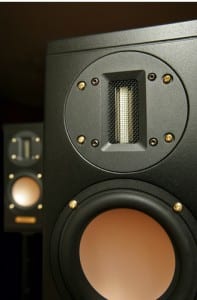 140mm Magnesium Alloy cone covering bass and mid frequencies and atop this driver sits a ribbon tweeter. The crossover is a second order affair. They really are a small speaker standing just 33cm high, with a width of 16cm and a depth of 20cm. They weigh in at 6Kg. The review sample came in a black textured paint finish that I’d initially assumed was some kind of leather/pleather covering, however, you can have them made in striking red and yellow colours too. Sensitivity-wise they’re 86dB, are a nominal 8 Ohm load (minimum 5Ohms) and they will handle up to 150Watts.
140mm Magnesium Alloy cone covering bass and mid frequencies and atop this driver sits a ribbon tweeter. The crossover is a second order affair. They really are a small speaker standing just 33cm high, with a width of 16cm and a depth of 20cm. They weigh in at 6Kg. The review sample came in a black textured paint finish that I’d initially assumed was some kind of leather/pleather covering, however, you can have them made in striking red and yellow colours too. Sensitivity-wise they’re 86dB, are a nominal 8 Ohm load (minimum 5Ohms) and they will handle up to 150Watts.
Inside the speakers are wired with silver plated copper to the tweeter and copper for the woofer.
With their gold fittings they certainly look pretty stylish in an understated and classy kind of way and the lack of grilles is certainly no loss…I rarely put grilles on speakers anyway, preferring to see the drivers at work. For £750 (factory direct) I certainly think the fit and finish is above average and the nicely finished plate for the speaker binding posts really finishes them off – you don’t see this in use obviously, but it’s this attention to detail that inspires a degree of confidence even before firing the speakers up.
On their website, Robson ask if these could be the ultimate desktop speaker and I’m sure some may very well use them in this kind of nearfield situation, but for the duration of their stay here at Hifi Pig they were placed on our custom built 50cm stands…which were actually the perfect height when slouched in my Ikea chair, but I would suspect that for people listening from a standard height chair/settee then 65cm would be a better proposition. That said, their foot print is slightly smaller than the powered speakers I use on my desktop.
Initially we placed the Opulus speakers in our large main listening area and it was clear that they were a little out of 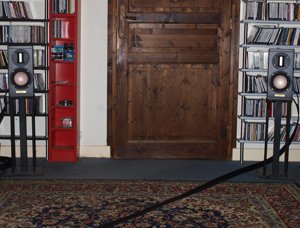 their depth trying to fill this space effectively…it’s a big space. Fortunately we have a smaller listening space off the main room which is more realistically proportioned at around 3m x 4.5m and it is here I did most of my listening. I had them firing down the length of the room, 150cm apart and around 20cm from the back wall, with the main listening position around 3m away. I believe this is a realistic position for these speakers and probably typical of the kind of environment they are likely to be used in.
their depth trying to fill this space effectively…it’s a big space. Fortunately we have a smaller listening space off the main room which is more realistically proportioned at around 3m x 4.5m and it is here I did most of my listening. I had them firing down the length of the room, 150cm apart and around 20cm from the back wall, with the main listening position around 3m away. I believe this is a realistic position for these speakers and probably typical of the kind of environment they are likely to be used in.
Sound
I spent a good deal of time listening to these little speakers without really taking much notice, taking notes, or playing the test tracks I like to throw at speakers and I have to say that I thoroughly enjoyed them. Whilst my preference in the main listening room is for large floorstanders (or larger standmounts) I could perfectly happily live with the Opulus Primas in this smaller space. There’s a really nice feeling of balance to the speakers that really lets you relax and get on with just listening to your tunes, whichever genre. I found myself delving further into my collection than I’ve been for a while and playing loads of different music (even some classical) and really connecting with it…which, the critical review process apart, is surely what hifi is all about. No, these little speakers don’t do trouser flapping bass, but they do go pretty low and the bass is tuneful and fast…no one note wonders these!
Anyway, the “job” here is to try and pull these speakers apart by giving them something to challenge them and search 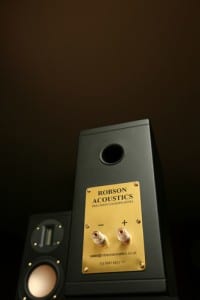 out their strengths and weaknesses, so on with Leftfield’s Rhythm and Stealth album which has deep basslines aplenty. Actually it’s surprising how much bass information these speakers convey. Phat Planet, which many will know from the Guinness adverts a few years ago, has complex beats and sub-basslines that can get quite confusing and incoherent on some loudspeakers. Not so here, the integration between that little woofer and the ribbon tweeter is seamless, offering up a sound that works as a whole, but still with the ability to pick out individual elements in the mix. On the dubby Chant of the Poor Man, I have to be fair and say that any more bass output would have been too much for the room. Soundstaging has decent depth and height, but does not extend massively beyond the sides of the speakers. Playing with toe in was interesting and I found the most pleasing image was when the speakers were firing directly at my head – slightly toed in…the classic set up. The feeling from a spatial point of view is very much like listening to a large speaker only on a smaller scale….if that makes sense. With electronic music I really expected the Opulus Primas to struggle, but they really don’t and that tightness of the bass and the crisp top end really compliment this style of music. Within the stereo image individual elements in the mix are properly positioned, sit stable and it’s easy to see why these are described as a “reference monitor” by Robson Acoustics.
out their strengths and weaknesses, so on with Leftfield’s Rhythm and Stealth album which has deep basslines aplenty. Actually it’s surprising how much bass information these speakers convey. Phat Planet, which many will know from the Guinness adverts a few years ago, has complex beats and sub-basslines that can get quite confusing and incoherent on some loudspeakers. Not so here, the integration between that little woofer and the ribbon tweeter is seamless, offering up a sound that works as a whole, but still with the ability to pick out individual elements in the mix. On the dubby Chant of the Poor Man, I have to be fair and say that any more bass output would have been too much for the room. Soundstaging has decent depth and height, but does not extend massively beyond the sides of the speakers. Playing with toe in was interesting and I found the most pleasing image was when the speakers were firing directly at my head – slightly toed in…the classic set up. The feeling from a spatial point of view is very much like listening to a large speaker only on a smaller scale….if that makes sense. With electronic music I really expected the Opulus Primas to struggle, but they really don’t and that tightness of the bass and the crisp top end really compliment this style of music. Within the stereo image individual elements in the mix are properly positioned, sit stable and it’s easy to see why these are described as a “reference monitor” by Robson Acoustics.
Popping on the nicely produced, eponymous Natalie Merchant album there’s that speed to the sound again…and a feeling of integration too. Whilst Merchant’s voice is clearly the main event, the rhythm section’s interplay and feeling of “integrated yet separate” sound the Primas give, adds pace and bounce to proceedings, with the tweeter rendering hi hats crisp and shimmery. Merchant’s voice is rendered very nicely and accurately with the Primas seeming to add very little character of their own.
Regular readers will know that one of my pet hates is a sloppy/slow sound and this is where theses little speakers really shine. Rage Against The Machine’s Killing in the Name is a good example of a tune that can sound messy on some loudspeakers, but here it is punchy and hard hitting. Likewise Deep Purple’s Smoke On The Water from their Made In Japan album with the grunty bass being well produced.
I mentioned the soundstage being quite narrow and not extending far beyond the speakers earlier, but put on Talvin 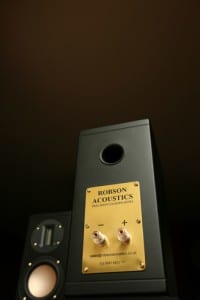 Singh’s Traveller from the OK album, where the width of the soundstage is exaggerated and it’s all there. Jerry, who used to review for Hifi Pig, often said where a particular pair of speakers would make him feel he was sat in the concert hall and with the Opulus Primas I got the impression of being fairly far back in the hall with a clear stage being portrayed in front of me. Indeed, referring back to the Made In Japan album it’s easy to “see” the musicians on the stage, or rather where they had been placed by the engineer on the desk.
Singh’s Traveller from the OK album, where the width of the soundstage is exaggerated and it’s all there. Jerry, who used to review for Hifi Pig, often said where a particular pair of speakers would make him feel he was sat in the concert hall and with the Opulus Primas I got the impression of being fairly far back in the hall with a clear stage being portrayed in front of me. Indeed, referring back to the Made In Japan album it’s easy to “see” the musicians on the stage, or rather where they had been placed by the engineer on the desk.
Conclusion
This is a good loudspeaker when not pushed beyond its limits! In the right sized space it offers a level of refinement and coherency that should be applauded for the asking price. In the average sized living room, or smaller space, it will perform perfectly well.
The Opulus Prima’s stand-out attributes are speed and integration and for these reasons it’s a speaker that really appeals to my tastes. There’s a distinct feel that you are listening to a quality near/mid-field monitor that has been refined and made fit for domestic use. There’s an accuracy to the sound that really does deserve the monitor description.
Given my saying that these are accurate and monitor-like speaker, you’d be forgiven for thinking that they are clinical and fatiguing…they’re not at all. On every kind of music I threw at them they performed really well and I found myself listening for hours on end and just relaxing into the music.
All in all I heartily recommend the Opulus Primas, they sound great for such a small speaker, have surprisingly low, fast and tuneful bass and the way in which the woofer and tweeter integrate makes for a really entertaining and engrossing listen.
Build Quality – 8.15
Sound Quality – 8.25
Value For Money – 9.1
Overall – 8.5
The Opulus Prima loudspeakers are a good value for money, great sounding loudspeaker, which will suit listeners looking for a fast and detailed sound.
The Opulus Prima’s will now go for second review to see if they will achieve Outstanding Product Award status. You can read the full results of Janine Elliot’s second review below.
Getting the chance to give a second review on a pair of speakers with ribbon tweeters was something I grabbed at gently – well, ribbons are very fragile beasts. As a lover of Townshend Maximum Supertweeters, I like their unfettered clarity and speed. Whilst for the majority of the review I stuck to one particular amplifier and source, I did initially listen to several systems and interconnects, knowing their idiosyncrasies and therefore what I knew was possible. This included powerhouses from Krell, Quad, Manley and Sony. I finally decided to do my listening via the Propious mono blocks from Graham Slee (another ‘cottage’ British company better known for small headphone amps and phono stages) and using their Magestic DAC preamp. I chose the Slee amps because their Class AB design, following proven old-school transistor topology, giving a faithful, flat and full frequency response in a pint pot 25W design, a bit like the sound I found from these minute speakers themselves. It reminded me of my Videotone Minimax speakers of the 70’s. Their introduction amazed the hi-fi press with the amount of sound available from such a small space. This speaker, however, has come a long way from my 70s youth. Mid and top frequencies were bullet proof. Hence, I decided for this review to use sources digital 24/192 sources as well as digital outputs from CD, digital radio via TiVo box and some vinyl.
Rob Hudson, founder of Robson Acoustic, is firmly of the belief that amazing sound quality shouldn’t have to break the bank. Indeed, the Opulus Prima comes in at only £750 if bought direct from their factory. Unpacking this Northumbria company is like a pandora’s box of toys. There is so much that this company is producing; this includes no less than 8 speakers – all with ribbon speakers costing up to £12,000+, a power amp, passive preamp and a media server. Me thinks I need to look into this company a bit more.
The Opulus Prima is their cheapest speakers, but in no way do they look cheap. Finished in a strong nextelle type paint in either black, red or yellow, they are certainly tough little boxes. The ribbon tweeter uses a specially chosen Clarity Cap capacitor giving them incredible high frequency detail and dynamics belittling their size. The sample I received was beautifully finished, though the screws holding the bass unit into the “box” were loose after traipsing across La Channel from their first review in France. Easily screwed back in. Maybe the company should look at a different air-tight fixing system. The rear ported 2-way unit looked smart, but as your stereotypical female I found the rough surface could attract a bit of debris and dust. A small cost for such a mightily good design. Topped off with a classy metal name print on the front of these cover-less monitors, this tall narrow design fitted beautifully on top of my weighted Atacama stands. At last a company that does away with the pointless fabric covers.
Compared with aged and modded BC1 and my LS3/5a’s these monitors had a slightly narrower soundstage, though instruments were clearly defined no matter what I played at it. Even with the 25W Slee these speakers punched for England. Using a top-end Sony transport feeding bits into the Slee DAC I could sense a slightly warm mid-range in Mike Valentine’s Chasing the Dragon tracks. The Bach Cello prelude recorded out door could sense the atmosphere and hear the birds but there was a little compression heard in the louder sections, which I didn’t hear in the delicate LS35/a’s. The student orchestra on track 13 with the Decca-tree mic’ing, didn’t do the musicians much favour, but you felt you were there in the audience. It just lacked the depth and deep bass available in larger and more expensive speakers. Whilst bass end was limited due to physics, the top end, thanks to the ribbon tweeters, was quick, precise, and tireless. Indeed the accuracy at all frequencies, and its depth of soundstage, would make excellent studio near field monitors.
Continuing my look for badly recorded music, David Bowie album ‘The Next Day’ sounded less cluttered than I was used to, for example the forward and rear soundstage on track 3 ‘The Stars are Out Tonight’, though it was more ‘tizzy’. Whilst my Graham LS5/9 might offer extra space, and of course an extra octave, I found the Robson Audio’s were faster. The next track showed just how good the forward and rear soundstage was for such a small size, and price. As an introduction model in the RA fraternity it left me wanting to hear more. Swapping again with my prized Chartwell LS3/5a’s was not easy to compare – they were just so different despite similar size. The bass was better in the Robson, but the soundstage not so clear as the BBC Chartwell LS3/5a’s . I couldn’t reach out and touch the musicians, as I could on the BBC design. On some music the sound compressed when pushed, where my 15ohm 15W Chartwells handled with ease.
‘Pictures at an Exhibition’ (Minnesota Orchestra, “Tutti! Orchestral Sampler) was amazingly strong, and ‘Walking in the Moon’ by The Yuri Honing Trio had a surprisingly powerful baseline, that managed to keep itself tight and well controlled. I’m always in favour of small bass/mid units as they can keep a tighter bass. The drum solo mid into ‘Cotton Tail’ Dee Dee Bridgewater was tight and all correctly placed in front of me.
So, how do I conclude my prognostication on this piece of equipment. To say I was surprised is an understatement. Whilst these 140mm Magnesium Alloys can get pretty low (42Hz +/-2dB is stated) and the ribbons get to frequencies my bat might like, they are low output by today’s standards at 86dB/metre, meaning levels need to be risen a wee bit. But if that means I need to turn a knob just once that is not a problem to me. These speakers are so clear and precise they put many speakers at least twice the price to shame. They tick all the right boxes for me. Working best in smaller living rooms and away from walls and with power amplifiers with enough grunt to push them a bit when needed. My only criticism is a slight compression in sound with some music I played.
Build quality 8.2 (despite the bass/mid driver fixing)
Sound quality 8.3
Value for money 9.0
Total 8.5
How we carry out reviews.
Read more Hifi Review.

























































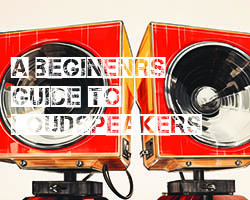


























































































































































You must be logged in to leave a reply.